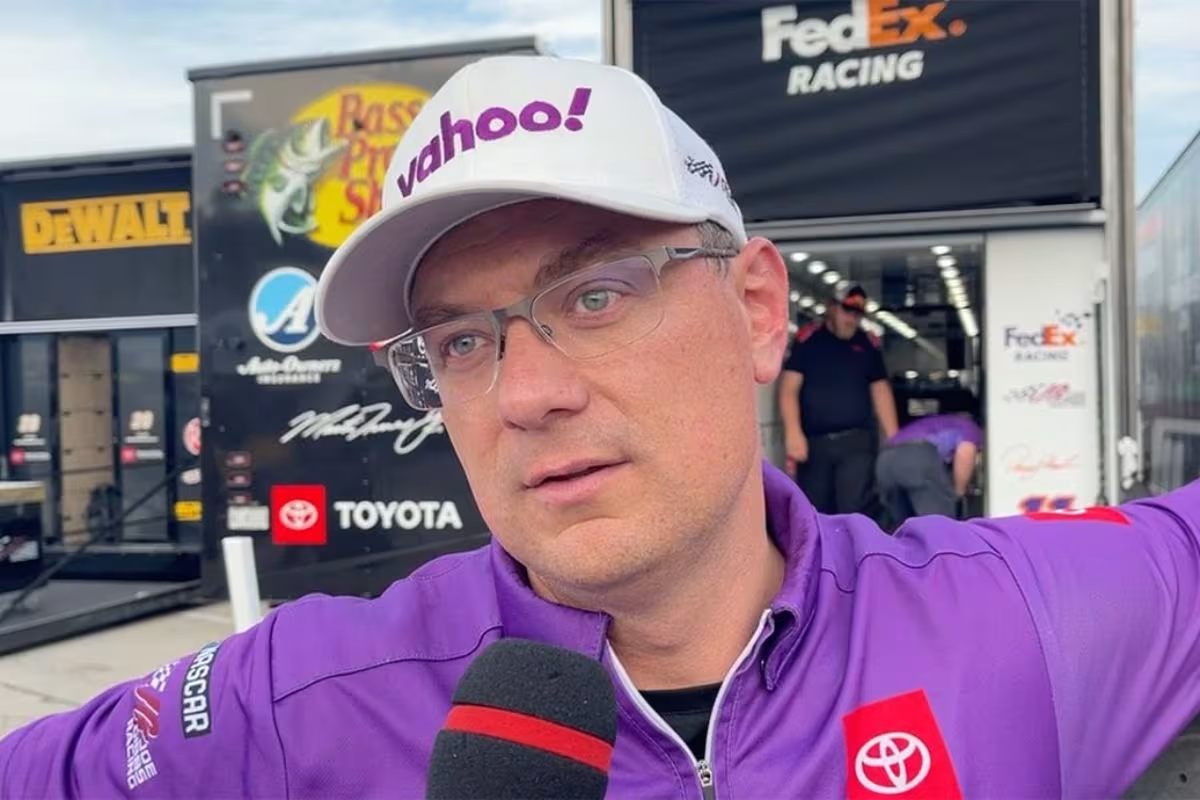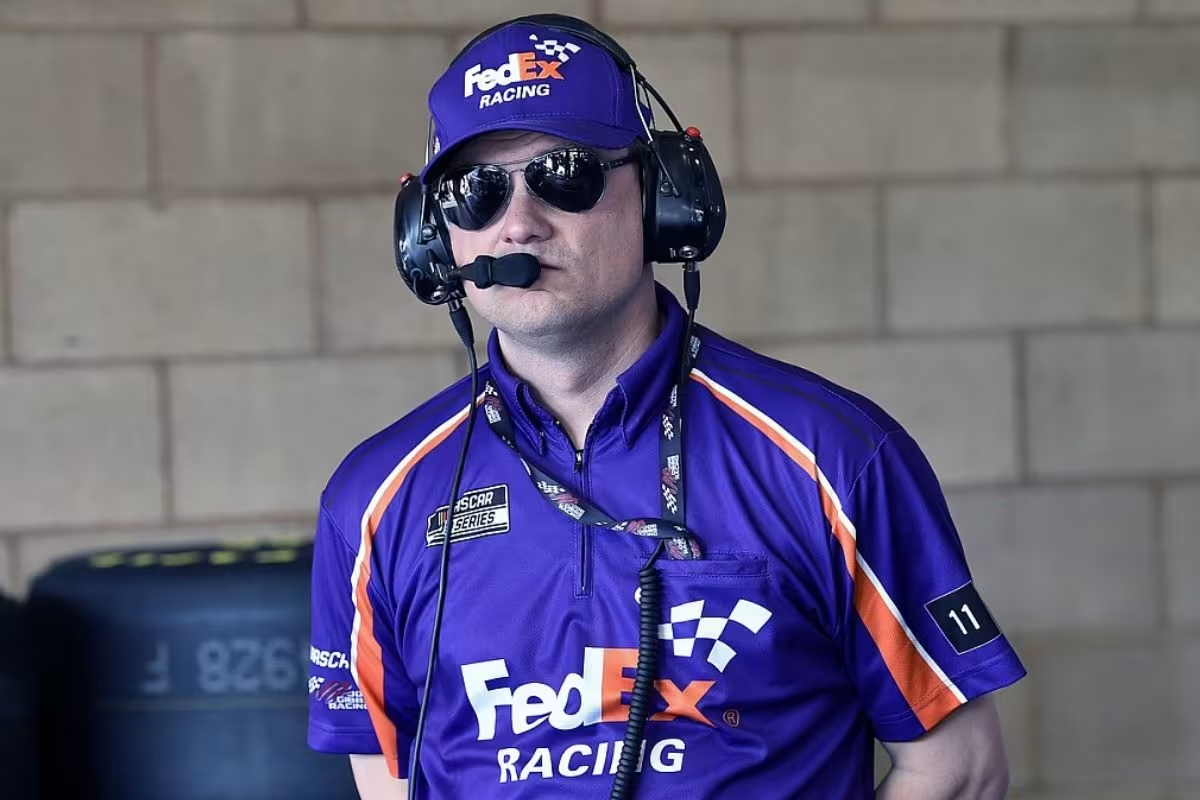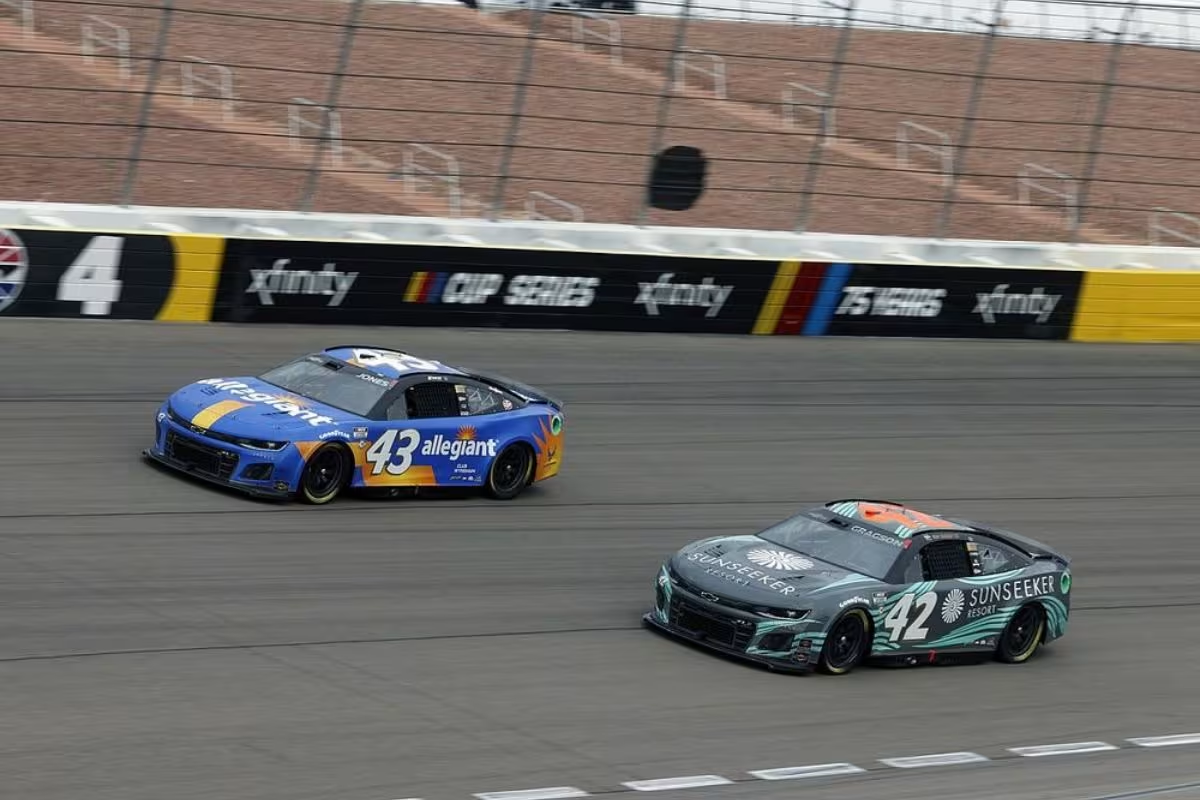Chris Gabehart Questions NASCAR’s DVP Integrity: NASCAR’s Damaged Vehicle Policy (DVP) is under fire after recent events have raised serious questions about how it’s enforced. A huge crash at Talladega led to unexpected rules being applied, leaving many fans and teams confused. Chris Gabehart, Denny Hamlin‘s crew chief, has spoken out about these inconsistencies, making it clear that something needs to change. As discussions heat up about possible reforms, fans are left wondering: how will NASCAR ensure fairness and keep the integrity of the sport intact?
Key Highlights
- Chris Gabehart criticizes NASCAR’s inconsistent application of the Damaged Vehicle Policy (DVP), undermining competition integrity and trust among teams.
- Frustrations arise from subjective interpretations by officials in assessing vehicle damage, leading to uneven enforcement of rules.
- Teams advocate for clearer guidelines and a more coherent framework for the DVP to enhance fairness and transparency.
- The recent changes in DVP allow teams more autonomy in evaluating vehicle safety, promoting competitive integrity.
- Ongoing discussions about safety standards and rule enforcement are essential to balance the competitive spirit with safety concerns.
Controversy Surrounding NASCAR’s Damaged Vehicle Policy (DVP)
NASCAR’s Damaged Vehicle Policy (DVP) is facing scrutiny after some recent events raised questions about how it’s applied. The big 28-car crash at Talladega led NASCAR to let drivers tow their damaged cars to the pits for repairs, which has sparked a lot of debate in the racing community.
This decision is confusing, especially when you look at past races. For example, drivers like Ryan Blaney and Josh Berry had to leave the race at Atlanta and The Glen because their damaged cars had to be towed straight to the garage under the same DVP rules.
These inconsistencies make it hard for NASCAR to be seen as fair and reliable. NASCAR’s Managing Director Brad Moran had promised that the DVP rules would not change, which adds to the confusion.
As NASCAR deals with this situation, it’s clear that they need to review how they apply the DVP and ensure fairness for all drivers. This incident shows that for NASCAR to keep its reputation as a top motorsport organization, it must maintain the integrity of its rules and treat all competitors equally.
NASCAR’s Plans to Improve the DVP Rule
Many within NASCAR are calling for revisions to the Damaged Vehicle Policy (DVP) to address the inconsistencies that have recently come to light. The current DVP mandates that a vehicle sustaining noteworthy damage must be towed to the garage, effectively sidelining it from the race. This stringent interpretation has led to confusion and controversy, prompting discussions about potential reforms.
Denny Hamlin’s crew chief, Chris Gabehart, has emerged as a prominent voice in advocating for clarity and fairness in the application of the DVP. He highlighted to SiriusXM NASCAR Radio that NASCAR is reconsidering its stance on immediate changes to the rule, suggesting a willingness to adapt.
“I am the proponent of vulnerability or not in the moment. I am a proponent of vulnerability or not in the moment. The rule is the rule, and in black and white, it’s stated that if you can’t drive—if you’re deemed in an incident and you can’t drive back to your pit box—you’re out of the race.” – Gabehart
View this post on Instagram
These proposed changes could promote a more equitable racing environment. By refining the DVP, NASCAR aims to improve both the integrity of the sport and the experience for teams and fans alike. Continuous dialogue among stakeholders will be essential to achieving a balanced and effective policy moving forward.
Chris Gabehart’s Criticism of NASCAR’s Inconsistency
Inconsistencies within NASCAR’s Damaged Vehicle Policy have drawn sharp criticism from Chris Gabehart, who highlights the need for clarity in rule enforcement. Gabehart’s observations reflect a growing frustration among teams regarding the uneven application of the rules, particularly when comparing incidents like those involving Josh Berry in Kansas. He noted that when a rule is applied consistently, teams can accept its judgment, regardless of its perceived fairness.
“No matter how good or bad that rule is, just like in Kansas with Josh Berry, that was the rule, and everybody can stomach it and understand it. What is confusing is when that doesn’t happen, no matter if it’s, gosh, a 40-car wreck, which it was close to. Then we can’t finish the race.” – Gabehart
However, the confusion arises when similar situations yield different outcomes, undermining the integrity of the competition. Gabehart emphasized that the objective of NASCAR’s DVP is not to eliminate competitors unnecessarily. Instead, the goal is to avoid penalizing teams due to subjective interpretations of damage assessment.
He pointed out that the reliance on officials to make these critical calls can lead to inconsistencies that impact race outcomes. When a notable incident, such as a 40-car wreck, occurs and yet the race continues, the lack of uniformity in decision-making becomes apparent, leading to an environment rife with uncertainty.
Clarity in rule enforcement is paramount for maintaining the integrity of the sport, and as Gabehart suggests, providing a consistent application of the DVP is fundamental for encouraging an equitable racing environment.
NASCAR’s Plans to Empower Teams Regarding DVP Rule
Amid growing concerns about the effectiveness of the Damaged Vehicle Policy (DVP), NASCAR is pivoting towards a more team-centric approach that empowers crew members to make critical decisions regarding their vehicles’ race readiness.
This tactical shift comes in response to feedback from team leaders, including Chris Gabehart, who have emphasized the necessity of granting teams more autonomy in evaluating vehicle condition post-collision.
NASCAR plans to improve its oversight of damage assessments while simultaneously allowing teams to utilize their expertise in determining the viability of their cars. As articulated by Denny Hamlin’s crew chief, this change aims to resolve ambiguous situations where vehicles may appear compromised yet have the potential to compete effectively.
“Their intent is not to put anybody out of the race that doesn’t mistakenly need to be. If they miss a judgment call or a damage type thing, they don’t want to put it on their officials on the ground. Because of that, they want to put it more in our hands.” -Gabehart
By placing the decision-making power back in the hands of the teams, NASCAR acknowledges the nuanced understanding crew members possess regarding their cars’ performance capabilities.
“If there are kind of calls on the fence that the cars can’t move, but we’re not sure how bad the damage is, they want to put it back in the teams’ hands and give them an opportunity to go out and compete again.” – Gabehart
Empowering teams to evaluate their own readiness aligns with the broader goal of promoting fairness within the sport, though it remains to be seen how this will impact the integrity of race outcomes.
Impact of the DVP Rule Change on NASCAR and Fan Reactions
The recent changes to NASCAR’s Damaged Vehicle Policy (DVP) have stirred a wave of reactions from both teams and fans, as the sport grapples with the balance between safety and competition. The alterations have particularly aligned with the desires of the teams, who have long sought increased autonomy in evaluating vehicle safety post-incident.
For instance, the cases of Ryan Blaney and Josh Berry underscore a growing frustration with the previous rigid application of the DVP, where drivers were sidelined despite their willingness to continue racing if conditions permitted.
Critics, including prominent voices like Jeff Gluck, have highlighted the inconsistency in rule enforcement, questioning how certain drivers appeared to receive leniency while others were not afforded the same opportunity. This inconsistency has led to calls for a clearer, more stable policy that would eliminate confusion, especially during critical playoff periods where every decision can have major implications.
“When you say last week and you have made it very clear, Blaney’s thing and this thing with Berry, if you can’t drive it back, you’re out. And then they like go to great huge thing of pulling Briscoe out of the grass, pulling Chase [Elliott], and Harrison Burton by the way, too, got towed back. Why? I don’t know, man. Why can’t we have a clear policy that doesn’t change week to week? By the way, this is the playoffs. By the way, this stuff matters because the whole format is short seasons, short mini-seasons. So, it’s just, it’s not good.” – Gluck
With NASCAR’s decision to empower teams, there is a tangible shift in the dynamics of race management. Fans, while appreciative of the potential for more competitive racing, remain cautious. They desire transparency regarding how teams will evaluate car safety moving forward.
News in Brief: Chris Gabehart Questions NASCAR’s DVP Integrity
The ongoing debate about NASCAR’s Damaged Vehicle Policy (DVP) raises important questions about fairness and consistency in the sport. Chris Gabehart, a prominent crew chief, has voiced his concerns about how the DVP is enforced, highlighting the need for clear and fair rules.
NASCAR is looking to make improvements to the DVP to address these issues. The goal is to give teams more power and create a more balanced competition. If these changes happen, they could help teams develop better strategies and make races more exciting for fans.
ALSO READ: Chris Gabehart Promises Redemption for Denny Hamlin After Kansas Disappointment




